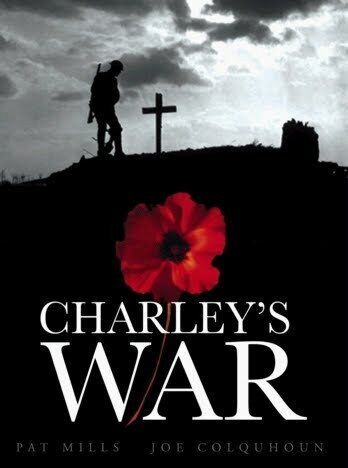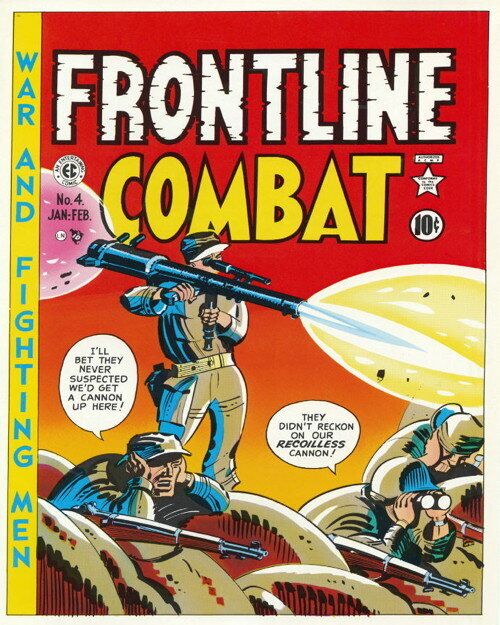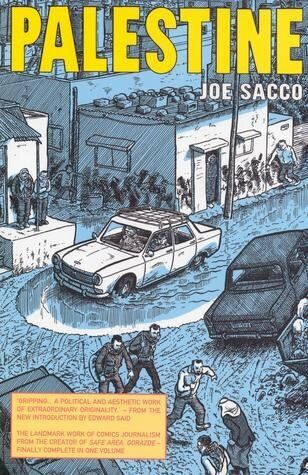What on earth is the Imperial War Museum in London doing organising an event called "Comics & Conflicts" one might well ask? Stereotyped as fluffy entertainment they may be, but the IWM event, held on the weekend of the 19th-20th August, was a simple acknowledgment of the significance of the modern comic book and graphic novel to report and represent stories of war in a rich variety of ways. Such is the wealth of material on warfare to be found in the comics medium that the IWM event packed in a day-long international academic conference, one-off in-conversations with comics creators, panels, workshops, the documentary Comics Go To War, and exhibitions of rare war comic artwork.
War comics have been around as long as comic books themselves -which means since the 1930s. Evolving out of newspaper strips, the modern comic book truly exploded in the United States with the success of Detective Comic's Action Comics # 1 featuring a caped character called Superman. Superman debuted in 1938 with storm clouds already gathering over Europe, so comics arguably were born in war.
It would take an academic essay to truly illuminate the history and variety of the war comic, but we can take a brief trawl here through those comics that many creators and critics at the IWM event held up as worthy examples of the genre. A brief dip alone throws up an embarrassment of riches, a handy guide for those looking to learn more and maybe start a collection.
WWII looms large in the war comic genre for obvious reasons, but wars where combatants had to look each other in the eye rather than aim down a rifle have been the fuel for several major comics works. Frank Miller's 300 (Dark Horse, 1988) retells the 480 BC Battle of Thermopylae with the dramatic and intense blood-spattered artwork and stylised dialogue that Miller has become famed for. It is a heady mix.
British comic writer Warren Ellis tackled the Hundred Years war in Crecy for Avatar Press in 2007, depicting the invading English battling the French in 1346. The artwork by Raulo Caceres illustrates in exquisite detail a story of a turning point in the development of modern warfare and the end of chivalry. Caceres's panels of arrow volleys striking mounted troops are beautiful and brutal.
Plenty of American teens have no doubt used their illustrated adaptation of Stephen Crane's 1895 novel The Red Badge of Courage to learn about the American Civil War. Its a fine example of not only a comic set in post-independence America, but of comic artists, in this case Wayne Vansant, being called on to illustrate academic texts about warfare.
It took over fifty years after the war's end for what many consider the definitive WWI comic, and one of the most acclaimed war comic series of all time, to come into existence. British war series Charley's War hit newsstands in 1975 in the pages of IPC's Battle Picture Weekly. What made this series stand out was its attention to detail and lack of sentimentality. Through the point of view of young Tommy recruit Charley Bourne, writer Pat Mills and artist Joe Colquhoun exquisitely rendered the daily struggles of the British infantryman on the frontline without jingoism or demonisation of the foe, the very human stories backed up by solid research. Running until 1985, it remains a landmark and is available today collected into new hardcovers.

The WWII period itself saw a largely jingoistic outpouring in comics in Britain and America. Captain America's first appearance in Timely comics in 1941 has him punching Hitler in the face. Plenty of publishers got on board to sock it to the Germans and the Japanese in many fantastical (and often racist) tales. The passing of a few decades allowed more complex comics set during that war to emerge, with a heyday of sorts emerging across the 1950-70s in the American and British markets whilst the very real Korean and Vietnam wars raged in the background. Many of the comics creators famous today as shaping the medium, such as Stan Lee, Joe Simon, Jack Kirby and Will Eisner, had had defining experiences serving in WWII and this could often be felt in the pages of war comics produced in the years after.
EC Comics' Two-Fisted Tales (1950) and Frontline Combat (1951) are well regarded as distinctive examples of the American war comic genre that avoided jingoism, did their research, and were out of step with the mainstream in their story and art choices (for example one Frontline Combat cover featured a crying Korean war orphan). They can be found in reprinted collections today.

The granite-jawed WWII grunt Sgt. Rock became something of an American comic book icon and was one of the first regular war characters to keep cropping up in continuous stories (as opposed to variety anthologies of war stories as were popular in Britain). He debuted in a six-page strip in 1959 in DC Comics's Our Army at War series and was taken on for the long term by writer Robert Kanigher and artist Joe Kubert. The character still soldiers on 50 years later. Our Army at War has been reissued in reprint collections, and Rock himself has been both reprinted and re-imagined.
Air warfare in WWII offered rich material for popular comic series. One of the most popular in Britain was the realistically illustrated (by Charley's War artist Joe Colquhoun) Johnny Red which appeared in Battle Picture Weekly in 1977, based around the novel concept of a British fighter plot joining the Soviet Air force. The series was recently collected in hardcover. In contrast the more recent Garth Ennis-penned short series Enemy Ace: War in Heaven (DC Comics 2001) is itself a re-imagining of a WWII comics character created in 1965 by Kanigher and Kubert. Enemy Ace offered the unique (and controversial for its time) prospect of seeing the air war from the POV of a German ace pilot - the Red Baron-esque Hans von Hammer.
One cannot overlook the popularity and importance in British comics of the war pocket picture library format. An invention born of necessity, the 60 page small-but-varied pocket volumes proved a hit when launched in the 1950s. There was little or no continuity or repeat characters, but audiences could therefore approach them with no prior knowledge and enjoy a variety of tales. Over 100000 were produced between 1960 -1992 and the titles became household names- War Picture Library (1958), Combat Picture Library (1959) Commando (1961), Battle Picture Library (1961) and Battle Picture Weekly (1975). Collectors prize the originals today, and newcomers can get reprinted collector's editions of Battle Picture Weekly, War Picture Library and Commando amongst others, the collections usually being built around certain theatres of war or "ten of the best", with WWII material the big draw. The covers were frequently spectacular and often drew on an international range of artists. Though these WWII comics and others had mostly faded in the American and British markets by the 1980s, D.C Thomson's Commando soldiers on to this day.
Keeping the war story anthology tradition alive today seemingly single-handedly is Northern Irish comics writer Garth Ennis. Ennis has penned two WWII series recently- War Stories in 2002 for DC Comics and Battlefields for Dynamite in 2007, both of which are available as collected editions. Particularly intriguing stories across both are J for Jenny- a story of a fated British bombing raid over the Reich and beautifully illustrated in a chiaroscuro style by David Lloyd (artist on V for Vendetta), and The Night Witches which tells the story of a Soviet bomber squadron piloted by women. These channel the atmosphere of the British war anthologies of old but bring in depth historical research and a fresh approach to the material, whilst bringing to light lesser known curious and moving episodes of that war.
With WWII-themed comics and the war comics genre itself fading by the 1990s, a new sub-genre of sorts was inadvertently kick-started by artist and writer Joe Sacco in 1993 through his Palestine series. Later collected into a graphic novel by Fantagraphics, it was hailed as a masterpiece of comic's reportage in its depiction of his journey into the Middle East to explore the Israeli conflict with Palestinians by talking to people on the ground. Sacco would go on to cover Bosnia in Safe Area Goradze (2002) and The Fixer (2004). Davis Axe and Steve Olexa's War Fix (2006) offered a look at the intoxicating side of the roving war reporter and is based, like Sacco's work, on Axe's personal experiences and eyewitness reports.

Brian K. Vaughan and artist Niko Henrichon'sPride of Baghdad for DC Vertigo (2006) offers a very intriguing way of approaching the 2003 Iraq conflict- its main characters are not soldiers but a pride of lions freed from their Baghdad zoo by wayward Coalition bombing. The metaphorical tale sees the lions, like the Iraqis, finding their newfound freedom to be a dangerous and uncertain thing.
But despite these recent intriguing experiments in putting war into comic books by way of reportage or personal memoir, by and large the war comic genre lies quiet in 2011. Most war comics now only live on in reprinted collections. Real war though, is still with us.
Those wanting to read more about the history and culture of the war comic and enjoy plenty of illustrations are well advised to get a copy of War Comics: A Graphic History, by Mike Conroy, from Ilex Books.